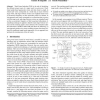Free Online Productivity Tools
i2Speak
i2Symbol
i2OCR
iTex2Img
iWeb2Print
iWeb2Shot
i2Type
iPdf2Split
iPdf2Merge
i2Bopomofo
i2Arabic
i2Style
i2Image
i2PDF
iLatex2Rtf
Sci2ools
ECAI
2008
Springer
2008
Springer
Word Sense Induction Using Graphs of Collocations
Word Sense Induction (WSI) is the task of identifying the different senses (uses) of a target word in a given text. Traditional graph-based approaches create and then cluster a graph, in which each vertex corresponds to a word that co-occurs with the target word, and edges between vertices are weighted based on the co-occurrence frequency of their associated words. In contrast, in our approach each vertex corresponds to a collocation that co-occurs with the target word, and edges between vertices are weighted based on the co-occurrence frequency of their associated collocations. A smoothing technique is applied to identify more edges between vertices and the resulting graph is then clustered. Our evaluation under the framework of SemEval-2007 WSI task shows the following: (a) our approach produces less sense-conflating clusters than those produced by traditional graph-based approaches, (b) our approach outperforms the existing state-of-the-art results.
Artificial Intelligence | Co-occurrence Frequency | ECAI 2008 | Target Word | Traditional Graph-based Approaches |
| Added | 19 Oct 2010 |
| Updated | 19 Oct 2010 |
| Type | Conference |
| Year | 2008 |
| Where | ECAI |
| Authors | Ioannis P. Klapaftis, Suresh Manandhar |
Comments (0)

